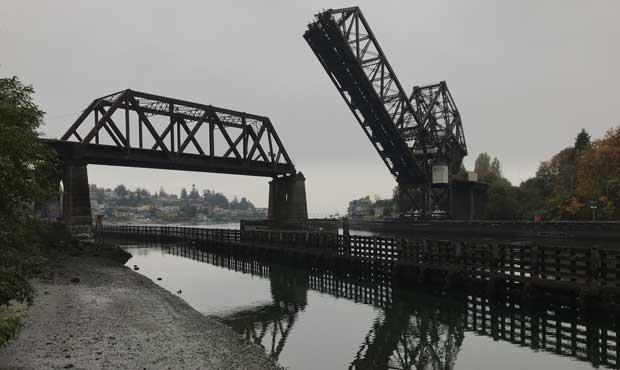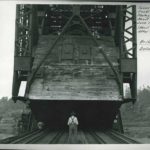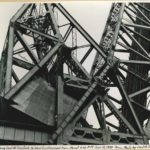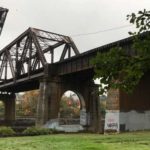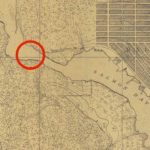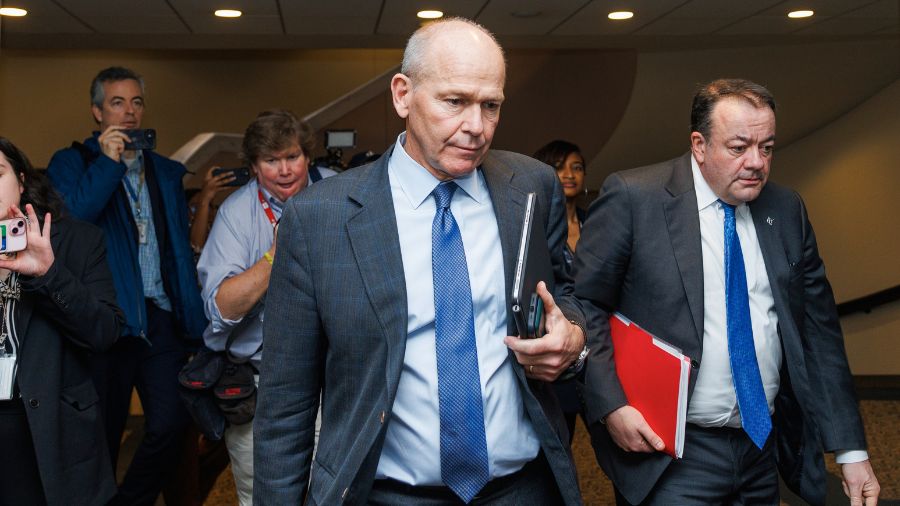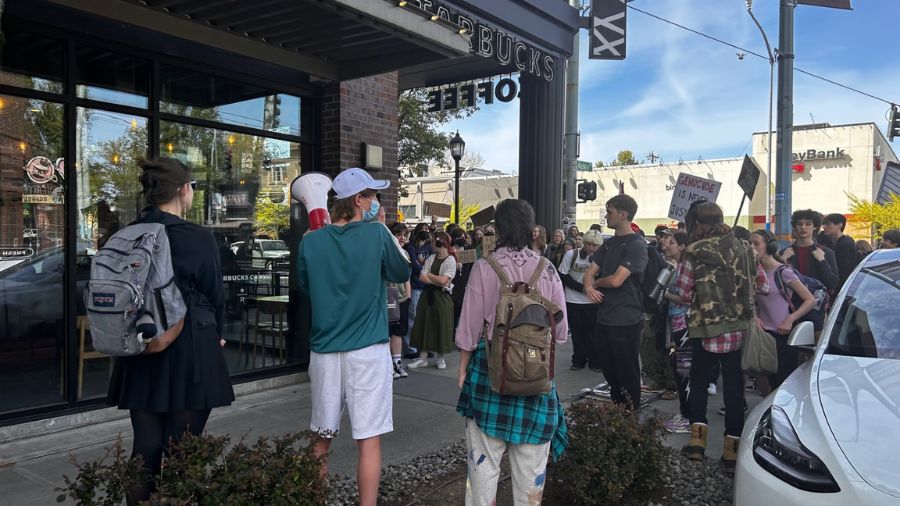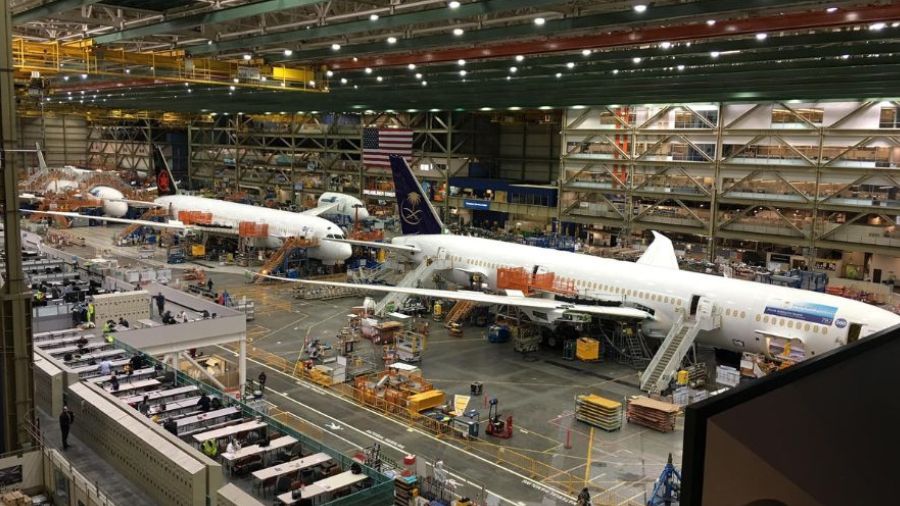End of the line for Seattle’s Salmon Bay Railroad Bridge?
Oct 10, 2018, 7:31 AM | Updated: Oct 11, 2018, 1:28 pm
An iconic Seattle railroad bridge that has stood at the western edge of the Ballard Locks for more than 100 years might be about to reach the end of the line.
BNSF Railway, the railroad company whose DNA includes much of what used to be the Great Northern Railway and the Northern Pacific, is in the early stages of seeking a permit from the US Coast Guard to replace the old railroad drawbridge that crosses Salmon Bay from Magnolia to Ballard, and carries 30-40 passenger and freight trains per day.
BNSF spokesperson Courtney Wallace says the 104-year old span is reaching the end of its useful life, and the railroad wants to be proactive about replacing a key part of its north-south rail line through Seattle.
RELATED: Remembering the infamous Kitsap Ferry riot of 1987
“We have the time, we have the budget, we have the resources, and we want to make sure it’s done right and done correctly,” Wallace said. “So we can get through the permitting process, get through construction, get the old bridge torn down, the new one in operation, [and] that way we’re not scrambling because there’s a bridge stuck in the up or down position, or even at a midpoint.”
Wallace says that the heart of the old bridge are its trunion bearings that allow the span to raise and lower. The design of the Salmon Bay Railroad Bridge is known as a “Strauss heel-trunion single-leaf bascule bridge” or, more simply, a “jackknife” bridge.
It’s been a distinctive sight for decades to anyone visiting the Ballard Locks and looking to the west. It’s visible from Interbay, Ballard, and Queen Anne Hill. The old span is made of riveted steel, with rusty steel trusses, and a huge section that seems to almost always be pointing nearly straight in the air, though this span actually tips down into place many times per day so trains can cross. For raising and lowering the span, the bridge gets help from a giant concrete counterweight that hangs over the north end of the structure, and that tops the scales at a million pounds.
Replacing a 100-year-old bridge
Courtney Wallace says that one of the reasons BNSF is seeking to replace the bridge now is because they recently did a major overhaul to the lift mechanism, but the work didn’t last as long as they’d hoped.
“We replaced trunion bearings about eight years ago, and we thought we had probably 10 or 15 more years after that, but we are starting to hear noises we heard eight years ago,” Wallace said. “So it really does make more sense to replace it now.”
Should BNSF succeed in getting the necessary permits, the new bridge they hope to build will cost $200 million dollars. The new structure will be a vertical lift bridge; instead of one end tipping into the air, the entire span will lift horizontally. If they get a permit, Courtney Wallace says it will take about three years to build the new bridge right alongside the old one — while the original remains in operation. Once construction is finished, they’ll realign the tracks to cross the new bridge, and demolish the 1914 span.
Salmon Bay Railroad Bridge
The Salmon Bay Railroad Bridge was originally built by the Great Northern Railway in 1913 and 1914. It was necessary to build a bridge because of the construction of the Ballard Locks and the Lake Washington Ship Canal, which were completed in 1917.
Before the canal was built, the Great Northern tracks from Seattle went north across the east end of Salmon Bay, on a curving trestle just west of the Ballard Bridge. The tracks then continued west to the shore of Puget Sound and on up to the Great Northern’s route across Stevens Pass and its international crossing at Blaine.
It’s this old Great Northern route that passenger trains still follow between Seattle and Vancouver, BC once they get north of the Salmon Bay Bridge.
At the same time that the Great Northern was building the Salmon Bay Bridge, rival railroad the Northern Pacific built its own similar drawbridge across the Ship Canal just east of the Ballard Bridge. From this bridge, tracks branched in either direction: eastbound, along what eventually became the Burke-Gilman Trail and the Northern Pacific’s route to its international crossing at Sumas; and westbound to the Great Northern tracks.
The Northern Pacific bridge must have come in handy 70 years ago, when the Salmon Bay Bridge got stuck in the open position for six months.
Wallace says that in June 1948, the huge concrete counterweight on the Salmon Bay Bridge partially separated from the superstructure of the bridge and sat right down on the tracks. During the six-month closure to repair the Salmon Bay Bridge, all Great Northern Railway traffic was diverted at Interbay to the Northern Pacific bridge.
Nowadays, if the Salmon Bay Bridge were to get stuck in the up position, there’s no easy way around the Ship Canal, since the Northern Pacific bridge was torn down in 1976.
RELATED: Washington’s Panic of 1893
The early 20th century design isn’t the only old-school aspect of the Salmon Bay Railroad Bridge. At least one BNSF employee is stationed 24 hours a day, seven days a week, in a small shack on the east side of the structure. This bridge tender operates the span manually, working with train dispatchers to ensure that it’s in the down position for trains to cross, and keeping in touch with the Army Corps of Engineers’ lock operators to allow marine traffic to enter and exit the Ballard Locks when the span is in the up position.
Building a new bridge
There’s no timeline as yet for starting construction of the new Salmon Bay Railroad Bridge. Currently, BNSF is gathering input from the maritime community about such things as how high the vertical bridge needs to lift in order to not interfere with marine traffic.
Courtney Wallace says that the US Coast Guard is the lead agency for the federal permitting process, because the bridge directly impacts a navigation route, but other federal, state and local agencies will weigh in on other factors such as environmental impact and historic significance. Though the bridge was named as a City of Seattle Landmark in 1980, the city’s landmark designation placed no controls on the structure, and thus will have no impact on BNSF’s permitting process.
“For us, this is a working machine that needs to be replaced,” Wallace said. “We want to do it in a way that’s safe and efficient, and allows maritime traffic to move, allows rail traffic to move, and also we understand the historic nature of the bridge and we want to make sure it fits in with the community and it’s still able to do its job.”
While many questions remain unanswered about the project, Wallace is clear about a few things already.
For one, the new bridge will not have a pedestrian or bike path, for safety reasons. And they can’t leave the old bridge in place, permanently in the down position, to be turned into a pedestrian and bike bridge, as some have suggested. She also says that the new bridge won’t be designed to resemble the early 20th century appearance of the old bridge, though it will be made from unpainted steel that will ultimately rust, and the structure will have an “industrial look,” she says.
What about just leaving the old bridge in place, the span welded in the up position, as a kind of “history sculpture garden” or “visual artifact” for all those people visiting the Ballard Locks and looking west?
“It wouldn’t make any sense to do that,” Wallace said. “We’d still have to maintain it for safety reasons. It just doesn’t make sense.”
Follow @https://twitter.com/feliksbanel

